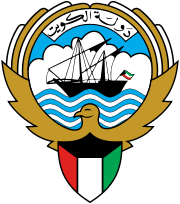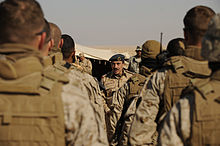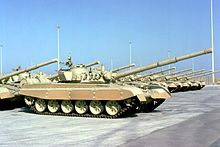- Military of Kuwait
-
Military of Kuwait Service branches Army, Navy, Air Force, National Police Force, National Guard, Coast guard Leadership Chief of Staff Air Marshal Fahad Al-Amir Minister of Defense Sh. Jaber AlMubark AlSabah Manpower Military age 18 Available for
military service900,745 (2010 est.), age 15–49 Fit for
military service857,292 (2010 est.), age 15–49 Reaching military
age annually22,000 (2005 est.) Expenditures Budget $4.7 billion (2008)[1] Industry Foreign suppliers  United States
United States
 Russia
Russia
 Egypt
Egypt
 United Kingdom
United Kingdom
 France
France
 Germany
GermanyUnder the constitution of Kuwait, the Emir of Kuwait is the supreme commander of the armed forces with a Minister of Defence who directs the Military of Kuwait through the Chief of the General Staff. The National Guard has its own commander, who reports directly to the minister of defence. Public security forces report to the minister of interior. The ruling As Sabah family maintain a tight grip on the centers of power, including many senior posts in the security services.
Since 1999 women have served as part of the police forces.
Contents
Organization
The Military of Kuwait consists of the following organizations:
The Kuwaiti Army is the primary land force of the Military of Kuwait. Kuwait's postwar equipment orders include 200[citation needed] M-84 tanks (from Yugoslavia to offset previous Yugoslav oil purchases[citation needed]) and eighteen self-propelled 155mm guns from France. Kuwait also has received United States, Russian, and Egyptian armored vehicles. [1]. The Kuwaiti Navy is the Kuwait Naval Force, is the sea-based component of the Military of Kuwait. The headquarters and sole naval base is Ras al-Qulayah Naval Base, located in the south of Kuwait, approximately 35 miles (56 km) south of Kuwait City. The Kuwait Naval Force numbers approximately 2,000 officers and enlisted personnel, including approximately 400 coast guard. The Kuwait Air Force (al-Quwwat al-Jawwiya al-Kuwaitiya) is the air arm of the State of Kuwait. The Air Force headquarters is located at Al Mubarak Air Base, with the remaining forces stationed at Air Defence Brigade, Ali Al Salem Air Base and Ahmed Al Jaber Air Base. The Kuwait Air Force numbers approximately 2,500 officer and enlisted personnel. The Kuwaiti National Guard is an internal and border security force.
History
Kuwait was a British protectorate from 1899 until 1961 and although a succession of Emirs of the Al Sabah ruled the country, foreign affairs and defence was a British prerogative[citation needed]. Kuwaiti forces consisted of the Emir's guard plus a small 600-man police force or constabulary under British administration. By 1961, a British military mission had converted the constabulary into a combined a brigade of 2,500 men which also established small air and naval forces in 1961.
With its small size and enormous oil wealth, Kuwait occupies a strategic position at the head of the Persian Gulf. Forty kilometers away is Iran, who had proclaimed its aim of exporting its Iranian Revolution[citation needed]; while the other powerful neighbor, Iraq, had repeatedly challenged Kuwait's legitimacy and subsequently invaded Kuwait twice. Fearful of the radical leadership in Iran, Kuwait aided Iraq during the Iran-Iraq War by permitting the transshipment of goods across its territory and by loans of about six billion US dollars[citation needed]. Kuwait responded to terrorist bombings and other violence inspired by Iran by intensifying its military cooperation with the GCC and by building up its own military. Formally neutral and reluctant to become involved with the great powers except as a last resort, Kuwait turned to the United States, the Soviet Union and Britain for naval protection of its tanker fleet after twenty-one ships were attacked in the gulf since late 1986.
Before the Persian Gulf War, Kuwait maintained a small military force with equipment supplied by the United Kingdom and the United States[citation needed]. Aside from the few units that were able to escape to Saudi Arabia, including a majority of the air force, all of this equipment was either destroyed or taken by the Iraqis. Much of the property that was returned by Iraq after the Persian Gulf War was damaged beyond repair.
Since the war, Kuwait, with the help of the United States and other allies, has made significant efforts to increase the size and modernity of their armed forces. These efforts are succeeding. The government also continues to improve defence arrangements with other Arab states, as well as UN Security Council members.
Kuwait has entered into a ten-year defence cooperation agreement with the United States (in September 1991), the United Kingdom, and France . The agreement with the United States includes port access, military equipment storage, and joint training and exercises. The agreement did not officially provide for the stationing of United States service personnel in Kuwait as the 1,500 US personnel remaining after the Gulf War were scheduled to leave within a few months.
Following Operation Desert Strike in 1996, Kuwait agreed to a United States battalion task force to be permanently stationed in Kuwait.[2] These US Army Intrinsic Action (later called Operation Desert Spring on 1 October 1999) rotations and US Marine Corps EAGER MACE rotations conducted combined training with the Kuwaiti Land Forces and other coalition partners. In addition, US Special Operations Forces conducted Iris Gold rotations to train and assist other Kuwaiti military units
US Forces
The United States stations at least 5000 troops in Kuwait as part of the Defence agreement. The largest part is the US Army Central Command (ARCENT) part of the United States Central Command or USCENTCOM.
US Forces current active facilities are:
- Ali Al Salem Air Base
- Camp Arifjan
- Camp Buehring
- Camp Fox
- Camp Patriot
- Camp Spearhead
- Camp Victory
- Camp Virginia
- Camp Wolf
- Kuwait International Airport
- Kuwait Naval Base
- Kuwait Navy Base
- Udairi Range
US Forces current Inactive facilities are:
- Ahmed Al Jaber Air Base
- Camp Doha
- Camp Moreell
- Camp Navistar
- Camp New York
- Failaka Island
- Mina Al Ahmadi
The Kabals are desert outposts (tent cities) with dining facilities, air-conditioned sleeping tents, recreation facilities and storage for weapons, tanks and their armoured vehicles. The kabals are named New York, New Jersey, Connecticut, Pennsylvania and Virginia[citation needed].
Equipment
The United States has provided military and defence technical assistance to Kuwait from both Foreign Military Sales (FMS) and commercial sources with all transactions made by direct cash sale. The US Office of Military Cooperation in Kuwait is attached to the American Embassy and manages the FMS program. US military sales to Kuwait total $5.5 billion over the last 10 years. Principal US military systems currently purchased by the Kuwait Defence Forces are Patriot missile system, F-18 Hornet fighters, and the M1A2 Main Battle Tank.
See also
- Kuwait–Iraq barrier
- Kuwait Ministry of Defense Web Site in Arabic and English
Notes
- ^ http://milexdata.sipri.org/result.php4 The SIPRI Military Expenditure Database
- ^ http://www.globalsecurity.org/military/ops/docs99/n10251999_9910253.htm
References and links
- CIA World Factbook
- Summary of Kuwait military power Summary of Kuwaiti military
- Kuwaiti Military at Global security
Kuwait Subdivisions Terminology Coat of arms
Coat of armsHistory Timeline · History of KuwaitLaw Courts · Nationality · LegislationPolitics Government · Legislature · Emir · Prime Minister · Departments · Constitution · Human rights (LGBT rights) · Elections · Parties · Foreign relationsGeography Geology · RiversEconomy History · Kuwait Stock Exchange · Kuwaiti dinar · Banks (Central Bank of Kuwait) · Transport · Communications · Energy · Tourism
Military Demography Culture Portal · TopicsMilitary of Asia Sovereign
states- Afghanistan
- Armenia
- Azerbaijan
- Bahrain
- Bangladesh
- Bhutan
- Brunei
- Burma (Myanmar)
- Cambodia
- People's Republic of China
- Cyprus
- East Timor (Timor-Leste)
- Egypt
- Georgia
- India
- Indonesia
- Iran
- Iraq
- Israel
- Japan
- Jordan
- Kazakhstan
- North Korea
- South Korea
- Kuwait
- Kyrgyzstan
- Laos
- Lebanon
- Malaysia
- Maldives
- Mongolia
- Nepal
- Oman
- Pakistan
- Philippines
- Qatar
- Russia
- Saudi Arabia
- Singapore
- Sri Lanka
- Syria
- Tajikistan
- Thailand
- Turkey
- Turkmenistan
- United Arab Emirates
- Uzbekistan
- Vietnam
- Yemen
States with limited
recognition- Abkhazia
- Nagorno-Karabakh
- Northern Cyprus
- Palestine
- Republic of China (Taiwan)
- South Ossetia
Dependencies and
other territories- Christmas Island
- Cocos (Keeling) Islands
- Hong Kong
- Macau
Categories:- Government of Kuwait
- Military of Kuwait
- Conscript militaries
Wikimedia Foundation. 2010.


